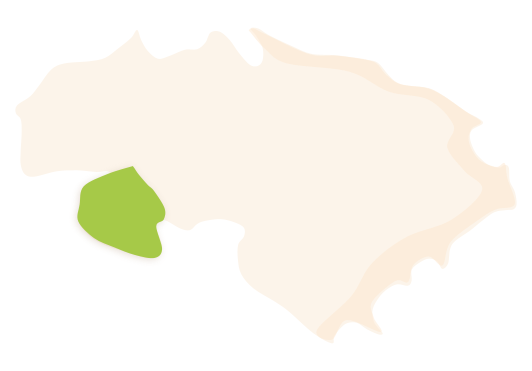Castell de Castells is the village that closes off the region to the southwest, in the inland area, bordering the two neighbouring regions: El Comtat with La Vall de Seta on one side and La Marina Baixa with Tàrbena on the other. Located at the end of La Vall de Pop, it stands at 551 metres above sea level, with an extensive mountainous area of 45.9 km² and 425 inhabitants, known as Castellencs and Castellenques.
 Castell de Castells' municipal district. Surface area: 45.9 km². Population: 425 (INE data 2021).
Castell de Castells' municipal district. Surface area: 45.9 km². Population: 425 (INE data 2021).HISTORY
Castell de Castells is a village surrounded by nature, with a mountainous topography full of ravines and cliffs. The mountain ranges that demarcate the village are L’Alfaro and La Serrella, and in the southwestern part lie the slopes of La Xortà, a mountain which reaches a height of 1,088 metres. Several ravines like Galisteo, Moliners, Foies, Xorquet, Castellet and others drain the area: they go in the direction of Castell de Castells and join the Castells stream to then become the Gorgos River. Next to one of these ravines, some cave paintings were discovered and the place was later declared a World Heritage Site. It is known as the Sanctuary of Petracos, and it is considered one of the most important neolithic sanctuaries in the Iberian Peninsula. These representations place Castell de Castells within the prehistoric period, at about 8,000 years ago. The village itself, however, has its origin in the ancient Castle of Serrella, which is why it is also known as Castell de Serrella. It was part of the territories controlled by Al-Azraq (1208-1276) until 1254, when Jaume I (1208-1276) incorporated it into the Crown of Aragon.
Under the watchful eye of Serrella Castle, other Muslim farmsteads filled today’s municipal area: Aialt, Bitla (or Vila) and L’Alcúdia de Castell (the current population centre). Even though some authors also consider Petracos as another one of these farmsteads, it seems it was founded later. In 1574, during the time of the patriarch Ribera, L’Alcúdia had thirty-five houses, Aialt had thirty and Vila had eight, all of them occupied by new Christian (or Morisco) families. Today they are deserted places that remain residually in the local toponymy.
Castell de Castells was a Morisco rectorship, with 170 houses at the moment of the expulsion, which they resisted with weapons in hand until they were defeated for good after destroying the church during the battle of El Pla de Petracos. The subsequent repopulation was carried out by Majorcan Christians, as one can see, for example, in the lineage continuity of surnames such as Estalrich, Mesquida, Pasqual, Tomb, etc.
The economy is eminently agricultural, with non-irrigated crops: almond, olive and carob trees. The cooperative oil mill is of interest, especially since the inhabitants use it to collectively press the olives for their families’ self-supply.
The music band of Castell de Castells, which has more than 100 years of history, is another deeply rooted and idiosyncratic group activity.
FESTIVITIES
- Saint Antoni is celebrated in January and the festivity includes a bonfire and a traditional barbecue by the Festers de Sant Antoni.
- The festivities in honour of the patron saint, Saint Anna, are celebrated on the 25th and 26th of July.
- The patron saint festivities are held from the 15th to the 18th of August.
- The festivities of the Petracos area take place on the 7th and 8th of September.
GASTRONOMY
- “Minxos” (a type of cross between a corn flour flatbread and a pancake) with “farinetes” and “borra” (made with beet, potato and other ingredients) is one of the most typical dishes in the area and one of the most representative of Castell de Castells. The “minxos” are made with water, salt, oil and flour.
- The “putxero” (stew) is one of the most prominent spoon dishes in Castell de Castells and, along with rice with rabbit and escargots, it is a good example of mountain and hunting cuisine.
- ”Borreta de melva” is a highly appreciated dish throughout the area, prepared with dried tuna, cooked slowly and completed with other local products.